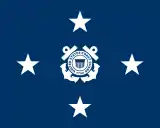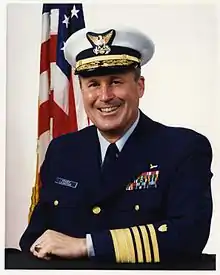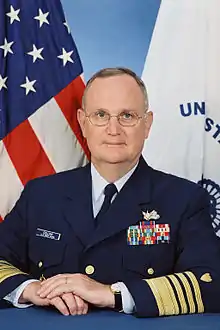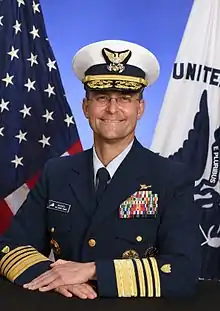List of United States Coast Guard four-star admirals
This is a complete list of four-star admirals in the United States Coast Guard. The rank of admiral (or full admiral, or four-star admiral) is the highest rank in the U.S. Coast Guard. It ranks above vice admiral (three-star admiral) and below Fleet Admiral (five-star admiral).

Coast Guard four-star admiral
There have been 21 four-star admirals in the history of the U.S. Coast Guard. Of these, 20 achieved that rank while on active duty and one was promoted upon retirement in recognition of combat citations. All were commissioned via the United States Coast Guard Academy or its predecessor, the School of Instruction of the United States Revenue Cutter Service. Prior to the Vice Commandant of the U.S. Coast Guard being elevated to a four-star position in 2016, all four-star admirals in the U.S. Coast Guard held the position of Commandant of the U.S. Coast Guard.
List of admirals
The following list of four-star admirals is sortable by last name, date of rank,[1] number of years on active duty at four-star rank (Yrs),[2] active-duty positions held while serving at four-star rank,[3] year commissioned and source of commission,[4] and number of years in commission when promoted to four-star rank (YC),[5] and other biographical notes.[6]
| # | Name | Photo | Date of rank [1] | Position [3] | Yrs [2] | Commission [4] | YC [5] | Notes [6] |
|---|---|---|---|---|---|---|---|---|
| 1 | Russell R. Waesche |  |
04 Apr 1945 |
|
1 | 1906 (USRCSSI)[7] | 39 | (1886–1946) |
| 2 | Joseph F. Farley |  |
01 Jan 1946 |
|
4 | 1912 (USRCSSI)[7] | 34 | (1889–1974) |
| 3 | Alfred C. Richmond |  |
01 Jun 1960 |
|
2 | 1924 (USCGA) | 36 | (1902–1984) Served as Commandant of the U.S. Coast Guard from 1954 to 1960 in the rank of vice admiral. |
| 4 | Edwin J. Roland |  |
01 Jun 1962 |
|
4 | 1929 (USCGA) | 33 | (1905–1985) |
| 5 | Willard J. Smith |  |
01 Jun 1966 |
|
4 | 1933 (USCGA) | 33 | (1910–2000) Superintendent, U.S. Coast Guard Academy, 1962–1965; U.S. Assistant Secretary of Transportation for Safety and Consumer Affairs, 1970–1971. |
| 6 | Chester R. Bender |  |
01 Jun 1970 |
|
4 | 1936 (USCGA) | 34 | (1914–1996) Superintendent, U.S. Coast Guard Academy, 1965–1967. |
| 7 | Owen W. Siler |  |
01 Jun 1974 |
|
4 | 1943 (USCGA) | 31 | (1922–2007) |
| 8 | John B. Hayes |  |
01 Jun 1978 |
|
4 | 1946 (USCGA) | 32 | (1924–2001) |
| 9 | James S. Gracey |  |
28 May 1982 |
|
4 | 1949 (USCGA) | 33 | (1927–2020) |
| 10 | Paul A. Yost Jr. |  |
30 May 1986 |
|
4 | 1951 (USCGA) | 35 | (1929– ) |
| 11 | J. William Kime |  |
31 May 1990 |
|
4 | 1957 (USCGA) | 33 | (1934–2006) |
| 12 | Robert E. Kramek |  |
01 Jun 1994 |
|
4 | 1961 (USCGA) | 33 | (1939–2016) |
| 13 | James M. Loy |  |
May 1998 |
|
4 | 1964 (USCGA) | 34 | (1942– ) Administrator, Transportation Security Administration, 2002–2003; U.S. Deputy Secretary of Homeland Security, 2003–2005. |
| 14 | Thomas H. Collins |  |
30 May 2002 |
|
4 | 1968 (USCGA) | 34 | (1946– ) |
| 15 | Thad W. Allen |  |
25 May 2006 |
|
4 | 1971 (USCGA) | 35 | (1949– ) Remained on active duty for 36 days after stepping down as commandant while serving as National Incident Commander, Deepwater Horizon oil spill. |
| 16 | Robert J. Papp |  |
25 May 2010 |
|
4 | 1975 (USCGA) | 35 | (1953– ) |
| 17 | Paul F. Zukunft |  |
30 May 2014 |
|
4 | 1977 (USCGA) | 37 | (1955– ) |
| 18 | Charles D. Michel |  |
24 May 2016 |
|
2 | 1985 (USCGA) | 31 | (1963– ) Served as Vice Commandant of the U.S. Coast Guard from 2015 to 2016 in the rank of vice admiral. First career judge advocate officer to achieve four-star rank in any service. |
| 19 | Charles W. Ray |  |
24 May 2018 |
|
3 | 1981 (USCGA) | 37 | (1959– ) |
| 20 | Karl L. Schultz |  |
01 Jun 2018 |
|
3 | 1983 (USCGA) | 35 | (1961– ) |
Tombstone admirals
The Act of Congress of March 4, 1925, allowed officers in the Navy, Marine Corps, and Coast Guard to be promoted one grade upon retirement if they had been specially commended for performance of duty in actual combat. Combat citation promotions were colloquially known as "tombstone promotions" because they conferred the prestige of the higher rank but not the additional retirement pay, so their only practical benefit was to allow recipients to engrave a loftier title on their business cards and tombstones. The Act of Congress of February 23, 1942, enabled tombstone promotions to three- and four-star grades. Tombstone promotions were subsequently restricted to citations issued before January 1, 1947, and finally eliminated altogether effective November 1, 1959.
Any admiral who actually served in a grade while on active duty receives precedence on the retired list over any tombstone admiral holding the same retired grade. Tombstone admirals rank among each other according to the dates of their highest active duty grade.
The following list of tombstone admirals is sortable by last name, date of rank as vice admiral, date retired, and year commissioned.
| Name | Date of rank (VADM) | Date retired (ADM) | Commission [4] | Notes | |
|---|---|---|---|---|---|
| 1 | Merlin O'Neill[8] | 01 Jan 1950 | 01 Jun 1954 | 1921 (USCGA) | (1898–1981) Commandant, U.S. Coast Guard, 1949–1954. |
Timeline
The first full admiral in the United States Coast Guard was Russell R. Waesche, who served as commandant from 1936 to 1945 and was promoted to that rank on April 4, 1945. His successor as commandant, John Farley, also inherited the rank of admiral. After Farley retired on December 31, 1949, the commandant's rank was reduced to vice admiral, although Farley's successor, Merlin O'Neill, was promoted to full admiral upon retirement in recognition of combat citations. O'Neill's successor, Alfred C. Richmond, remained a vice admiral until the commandant's rank was again elevated to admiral on June 1, 1960, where it has remained ever since.[9]

Notes
- Dates of rank are taken, where available, from the officer's official biography (U.S. Coast Guard, Commandants of the U.S. Coast Guard).
- The number of years on active duty at four-star rank is approximated by subtracting the year in the "Date of rank" column from the last year in the "Position" column.
- Positions listed are those held by the officer when promoted to admiral. Dates listed are for the officer's full tenure, which may predate promotion to four-star rank or postdate retirement from active duty.
- Sources of commission are listed in parentheses after the year of commission, and include the United States Coast Guard Academy (USCGA) and the United States Revenue Cutter Service School of Instruction (USRCSSI).
- The number of years in commission before being promoted to four-star rank is approximated by subtracting the year in the "Commission" column from the year in the "Date of rank" column.
- Notes include years of birth and death; awards of the Medal of Honor, Congressional Gold Medal, Presidential Medal of Freedom, or honors of similar significance; major government appointments; university presidencies or equivalents; familial relationships with other four-star officers or significant government officials such as U.S. Presidents, cabinet secretaries, U.S. Senators, or state governors; and unusual career events such as premature relief or death in office.
- Graduated from the Revenue Cutter Service School of Instruction, which became the United States Coast Guard Academy in 1915.
- http://www.uscg.mil/history/people/MONeillBio.asp
- U.S. Coast Guard, Commandants of the U.S. Coast Guard
References
- United States Coast Guard, Commandants of the U.S. Coast Guard & Chiefs of the Revenue Marine Division
- "Generals' Exodus", TIME Magazine, September 7, 1959
See also
- General (United States)
- List of active duty United States four-star officers
- List of United States Air Force four-star generals
- List of United States Army four-star generals
- List of United States Marine Corps four-star generals
- List of United States Navy four-star admirals
- List of United States military leaders by rank
- List of United States Public Health Service Commissioned Corps four-star admirals
- List of United States Space Force four-star generals